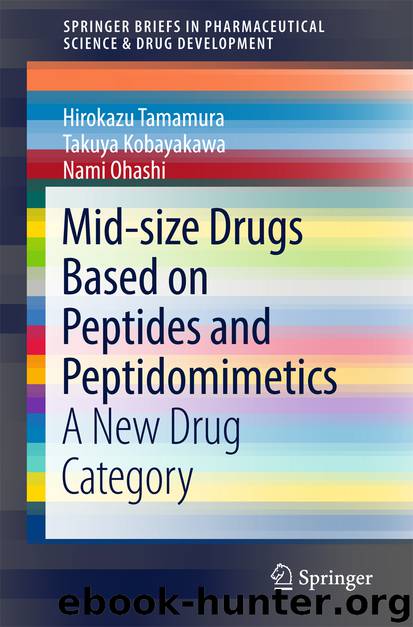Mid-size Drugs Based on Peptides and Peptidomimetics by Hirokazu Tamamura Takuya Kobayakawa & Nami Ohashi

Author:Hirokazu Tamamura, Takuya Kobayakawa & Nami Ohashi
Language: eng
Format: epub
Publisher: Springer Singapore, Singapore
The HIV-1 replication mechanism involving the dynamic supramolecular mechanism at the HIV entry and fusion steps has been elucidated and is shown in Fig. 3.1. At first, an HIV envelope protein, gp120, interacts with a cellular surface protein, CD4. This phenomenon causes a conformational change in gp120 and its subsequent binding to the cellular receptors, chemokine receptors such as CCR5 (Alkhatib et al. 1996; Choe et al. 1996; Deng et al. 1996; Dragic et al. 1996) and CXCR4 (Feng et al. 1996). CCR5 and CXCR4 are the main coreceptors used for the entry of macrophage-tropic (R5-) and T cell line-tropic (X4-) HIV-1, respectively. This binding triggers the exposure of another envelope protein, gp41, and the penetration of its N-terminus into the cell membrane, followed by the formation of the trimer-of-hairpins structure of gp41, which causes fusion of HIV to the cell membrane, completing the infection process (Chan and Kim 1998). The identification of this dynamic molecular machinery has encouraged us to develop new inhibitors which suppress HIVentry and/or fusion targeting the receptors, CD4, CCR5, and CXCR4, and the viral proteins, gp120 and gp41.
The first “fusion inhibitor”, enfuvirtide (fuzeon/T-20) (Roche/Trimeris), was approved by the Food and Drug Administration (FDA) in 2003 to treat patients with advanced HIV in combination with other anti-HIV drugs (Wild et al. 1993). A CCR5 coreceptor antagonist, maraviroc (Pfizer), was approved by the FDA in 2007 for use in combination with other anti-HIV drugs as an entry inhibitor for the treatment of patients infected with R5-HIV-1 (Walker et al. 2005). In 2007, the FDA approved the first “integrase inhibitor”, raltegravir (Isentress) (Merck Sharp & Dohme Corp.) (Cahn and Sued 2007; Grinsztejn et al. 2007). Subsequently, elvitegravir (Gilead Sciences, Inc./JT) was approved by the FDA in 2012 as an integrase inhibitor for use in patients starting treatment of HIV infection for the first time (Shimura et al. 2008; Sax et al. 2012). In 2013, dolutegravir (Shionogi/GSK) was also approved by the FDA as an integrase inhibitor, which has been marketed as Tivicay (Raffi et al. 2013). This book adopts CXCR4 antagonists, integrase inhibitors, vaccines/fusion inhibitors, CD4 mimics, and matrix/capsid fragment peptides, which include our research.
Download
This site does not store any files on its server. We only index and link to content provided by other sites. Please contact the content providers to delete copyright contents if any and email us, we'll remove relevant links or contents immediately.
The Poisoner's Handbook by Deborah Blum(2089)
Bottle of Lies by Katherine Eban(1763)
Mycelium Running: How Mushrooms Can Help Save the World by Paul Stamets(1640)
The Vaccine Race by Meredith Wadman(1627)
Missing Microbes by Martin Blaser(1552)
The Doors of Perception and Heaven and Hell by Aldous Huxley & Aldous Huxley(1548)
Pharmacy Practice and The Law by Richard Abood(1541)
Decisive by Chip Heath(1514)
28 Seconds by Michael Bryant(1484)
Steroids: History, Science, and Issues by Standora Joan E.; Bogomolnik Alex; Slugocki Malgorzata(1479)
McGraw-Hill Nurses Drug Handbook by Patricia Schull(1465)
The Doors of Perception: Heaven and Hell (thINKing Classics) by Aldous Huxley(1449)
Ganja Yoga by Dee Dussault(1422)
What's Making Our Children Sick? by Michelle Perro(1384)
Complete Guide to Prescription & Nonprescription Drugs 2014 by H. Winter Griffith(1324)
Stealing Fire: How Silicon Valley, the Navy SEALs, and Maverick Scientists Are Revolutionizing the Way We Live and Work by Steven Kotler & Jamie Wheal(1309)
Anatomy of an Epidemic by Robert Whitaker(1288)
Trip by Tao Lin(1261)
Cannabis for Chronic Pain by Rav Ivker(1199)
